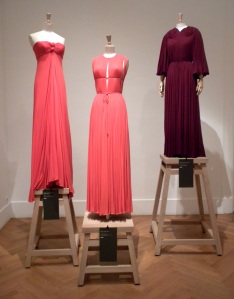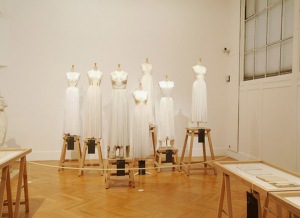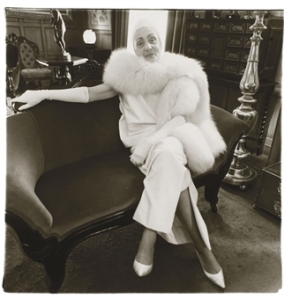I have recently become particularly enamoured with the fantastic French designer Mme Grès who specialised in statuesque Grecian mid-century masterpieces of fashion. Despite her work being extraordinarily popular she does not sit alongside the other fashion greats of this period however this comes as no surprise as many prominent women have been written out of the male dominated annals of history. The story of Mme Grès is a truly interesting and poignant one.
Born Germaine Emilie Krebs in 1903 to bourgeoisie Catholic parents in Paris, she became a couturier after being discouraged to pursue her original love of sculpture. She did an apprenticeship under the couture house of Premet before working as an assistant to a small couturier, Julie Barton. Soon Barton actually changed the name of her couture house to Alix, Germaine’s original pseudo name, to reflect her assistant’s new found success. She began to truly carve out a name for herself when she designed the costumes for Jean Giraudoux’s Surrealist play, ‘The Trojan War Will Not Take Place’. At this point she still worked under the name ‘Alix’ however it was after marrying Russian painter, Serge Anatolievitch Czerefkow, who signed his work with ‘Grès’, an anagram of his forename, that she began to work under this name too.
 Mme Grès’ work had a distinct style which she called her ‘Grecian formula’ and was quite unlike anything that other designers were doing at the time.
Mme Grès’ work had a distinct style which she called her ‘Grecian formula’ and was quite unlike anything that other designers were doing at the time.
 Her work was truly art and she never went down the more financially viable route of ready-to-wear which many of her contemporaries were doing but remained faithful to her couture background. Her work has a minimalist style – before it was ever fashionable – with a focus on stunning pleating and drapery which had a uniquely feminine touch for the period. Whilst other designers of the time were overworking their looks and putting their customers and models in corsets, Grès never used restrictive undergarments and worked with soft fabrics such as silk jersey and taffeta which were gentle against the female skin. She tended to work directly with the fabric, cutting and pining it onto models according to her sketches, with little preparation of toiles and patterns.
Her work was truly art and she never went down the more financially viable route of ready-to-wear which many of her contemporaries were doing but remained faithful to her couture background. Her work has a minimalist style – before it was ever fashionable – with a focus on stunning pleating and drapery which had a uniquely feminine touch for the period. Whilst other designers of the time were overworking their looks and putting their customers and models in corsets, Grès never used restrictive undergarments and worked with soft fabrics such as silk jersey and taffeta which were gentle against the female skin. She tended to work directly with the fabric, cutting and pining it onto models according to her sketches, with little preparation of toiles and patterns.
 Her love of sculpture was evident in her work which looked stiff and statuesque though her laborious efforts of shaping and draping the fabric so distinctively.
Her love of sculpture was evident in her work which looked stiff and statuesque though her laborious efforts of shaping and draping the fabric so distinctively.
Grès also incorporated within her style, in particular eveningwear, a rather risqué sensuality. She often featured cut out shapes of erogenous zones in prominent positions on her dresses which simultaneously left the garment rather revealing – quite unusual for this era’s formal wear.
Grès often used 20-30 metres of fabric on just one dress and could take 3 metres of fabric and reduce it to a tiny 7 centimetres through pleating alone. Not only did this give her dresses volume but also an inner structure that required no extra reinforcing garments such as corsets. Grès referred to herself as a sculpture of fabric rather than fashion designer.
During WWII, Grès fled Nazi occupied Paris after an argument with Barton however she retuned a year later in 1941 to open her own couturier business. The German’s were very disapproving of her excessive use of fabric and were also angered because Grès would not tell them the secrets of her unique fabric techniques. She was soon forced to close by the Nazi’s.
Grès was famous for her Grecian style which was wore by many celebrities of the era and still continues to be popular today – in fact many of her pieces could easily be on today’s catwalks and nobody would consider it ‘vintage’. She was not limited to this though and used a variety of different colours and techniques to create very different items, particularly when it came to daywear. Her signature fabric techniques, and sleeve construction on daywear, are still clearly evident though.
Mme Grès went from strength to strength in the thriving post-war fashion industry of the 1950s and 1960s. In 1972, she was elected president of the Chambre Syndicale de la Couture and soon after she became the first recipient of the Dé d’Or (Golden Thimble award), the highest honour from the Chambre Syndicale. During this period Grès began to turn over her creative control and in the early 1980s she actually sold the entire company – which was soon brought to ruin by the new owner. Her name, reputation and business which she had so meticulously built up over her lifetime was now finished. She retired to an apartment penniless and in obscurity, occasionally sewing orders for friends. At some point her daughter transferred her to a nursing home and nothing more was said or thought of Mme Gres – that is until the rather strange circumstances surrounding her death.
At some unknown point, Grès died quietly in her nursing home, but her daughter kept her death a secret for a full year. After the truth was discovered by a journalist, daughter Anne claimed that the secret was because she couldn’t afford the tombstone her mother deserved. During this period when it became public that Gres had indeed died, a retrospective of her work had taken place in New York and the curators said that they had been communicating with Gres in the lead up to it however it was now clear that at this point she had been dead. Daughter, Anne, had been the one communicating with the curators, posing as her mother, writing jovial letters with quotes and declaring that she was honoured to have the retrospective. There must have been embarrassment and shame in the Gres household surrounding her fall into obscurity and poverty whilst her contemporaries where becoming international fashion sensations.
Personally, I find Grès’ career and life quite fascinating and believe that this true artist of the fashion world should no longer be lost to history’s selective memory.











Greetings! I know this is kinda off topic but I was wondering if you knew where I could locate a captcha plugin
for my comment form? I’m using the same blog platform as yours and I’m having trouble finding
one? Thanks a lot!
It’s hard to come by well-informed people on this subject, however, you sound like you know what you’re talking about!
Thanks
Everyone loves it when folks get together and share thoughts.
Great website, stick with it!